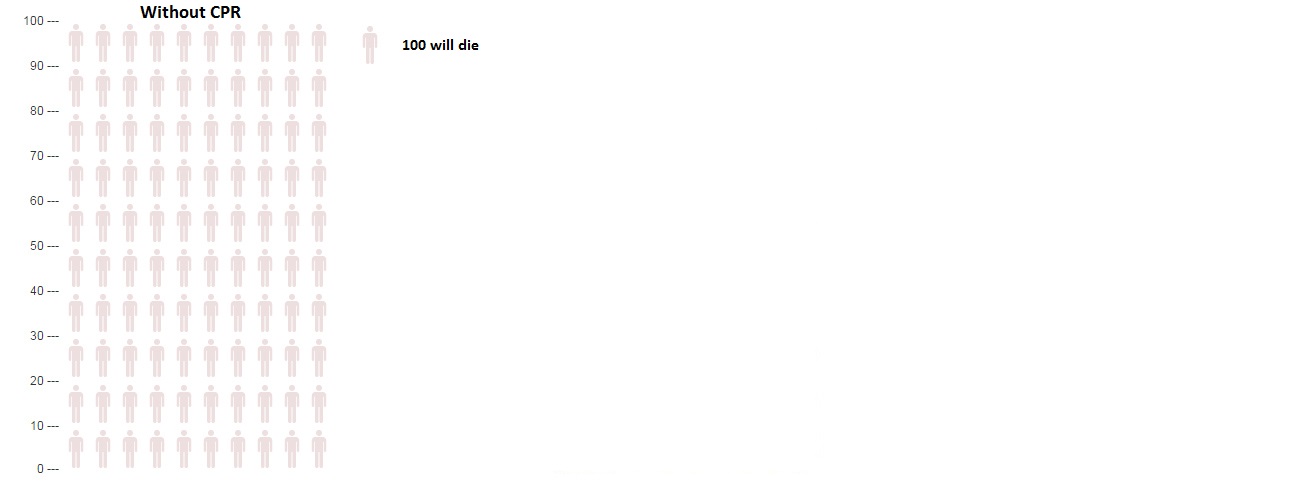Good Outcome Following Attempted Resuscitation (GO-FAR) Score to Predict Neurologically Intact Survival After In-Hospital Cardiopulmonary Resuscitation
Original paper: Ebell et al http://archinte.jamanetwork.com/article.aspx?articleid=1735894
Warning:This calculator should not be used alone, but in the context of shared decision-making between a doctor, a patient and his / her relatives.
Check each condition present on admission to the hospital to calculate total score and probability of survival.
Patient's age:
PROTECTIVE FACTOR
RISK FACTORS
Image: Icon Array
| Definitions of Predictor Variablesa | |
|---|---|
| Variable | Definition |
| Acute stroke | Documented diagnosis of an intracranial or intra-ventricular hemorrhage or thrombosis during the current admission |
| Hepatic insufficiency | Evidence of hepatic insufficiency within 24 h of the event, defined by total bilirubin >2 mg/dL (to convert to micromoles per liter, multiply by 17.104) and AST > 2 times the upper limit of normal or cirrhosis |
| Hypotension or hypoperfusion | Any evidence of hypotension within 4 h of the event, defined as any of the following: SBP <90 or MAP <60 mm Hg; vasopressor or inotropic requirement after volume expansion (except for dopamine ⇐ 3 microgram/kg/min); or intra-aortic balloon pump |
| Major trauma | Evidence of multisystem injury or single-system injury associated with shock or altered mental status during the current hospitalization |
| Metastatic or hematologic cancer | Any solid tissue malignancy with evidence of metastasis or any blood-borne malignancy |
| Pneumonia | Documented diagnosis of active pneumonia, in which antibiotic therapy has not yet been started or is still ongoing |
| Renal insufficiency or dialysis | Requiring ongoing dialysis or extracorporeal filtration therapies, or serum creatinine >2 mg/dL (to convert to micromoles per liter, multiply by 88.4) within 24 h of the event |
| Respiratory insufficiency | Evidence of acute or chronic respiratory insufficiency within 4 h of the event, defined as any of the following: PaO2/FiO2 ratio <300, PaO2 <60 mm Hg, or SaO2 <90% (without preexisting cyanotic heartdisease); PaCO2, ETCO2, or TcCO2 >50 mm Hg; spontaneous respiratory rate >40/min or <5/min; requirement for noninvasive ventilation (eg, bag-valve mask, mask CPAP or BiPAP, nasal CPAP or BiPAP), or negative pressure ventilation; or requirement for ventilation via invasive airway |
| Septicemia | Documented bloodstream infection in which anti-biotic therapy has not yet been started or is still ongoing |
Abreviations: AST: aspartate aminotransferase; BiPAP: bilevel positive airway pressure ; CPAP: continuous positive airway pressure ; ETco22: end-tidal carbon dioxide pressure ; Fio22: fraction of inspired oxygen; MAP2: mean arterial pressure; SaO22: arterial oxygen saturation; SBP: systolic blood pressure; TcCO22: transcutaneous carbon dioxide pressure .
aAdapted from the American Heart Association.

